Victoria Sadler's Blog, page 5
February 12, 2016
Review: Avedon Warhol, Gagosian Gallery 'Effortlessly Cool'
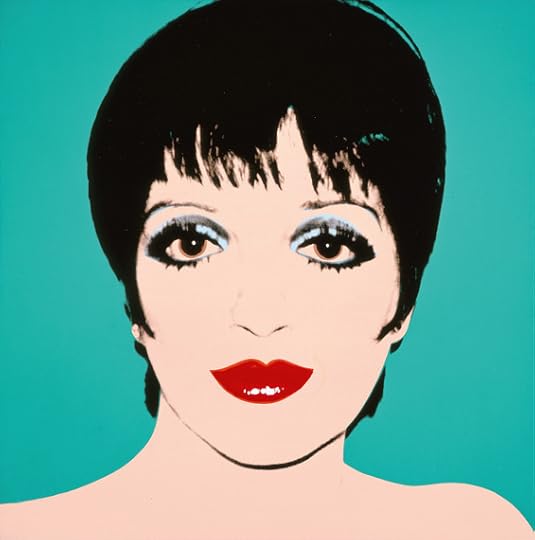
Do you know what the hardest challenge is for an arts and culture writer? Adjectives. They are a nightmare. How can we convey to you the spirit of a show without resorting to overused and familiar descriptions such as 'stunning' and 'exciting', or 'insightful' and 'reflective' ? And how can we encourage you to visit shows that we love without resorting to a flood of clichés?
And all of this is brought into sharp focus by this terrific new show at the Gagosian Gallery in Britannia Street that, for the first time, pairs the works of photographer Richard Avedon and Pop art maestro Andy Warhol in a single exhibition.
It's a nightmare as this show captures all these emotions. Of course it is glamorous and effortlessly cool. How can it not be? You've got Liza's portrait alongside Jackie Kennedy's. Marilyn is sharing a wall with Elvis, and Bianca Jagger is hanging out opposite Mao.

Together Avedon's and Warhol's works weave together a tapestry of a time that was the height of pop culture. This was the era when legends were born and icons were made.
But yet, there are times when this exhibition is - genuinely - tender and reflective. For these icons lived and died, just as we will live and die. But here they are immortalised. Forever captured at the pinnacle of their vivacity and fame.
And all this captured in a single exhibition that doesn't even charge an admission fee.
Avedon Warhol is a captivating blend of famous faces with the influential sub-culture that surrounded them. Avedon's posed black and white studio portraits share gallery space with Warhol's instantly familiar Pop Art canvases. Take, for example, the mammoth black and white Richard Avedon photograph of the members of Warhol's Factory hanging alongside vivid Warhol square canvases of Iranian royalty.
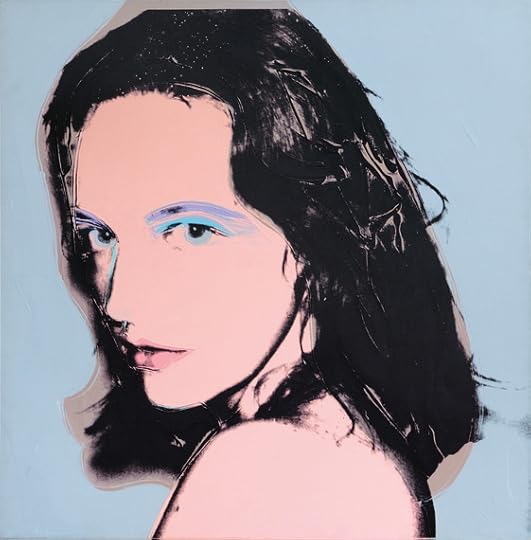
It's a heady assault on the senses and conjures up a world both gone, yet also enduring.
And there are some great curatorial touches here. High-five to whoever decided to hang Warhol's monumental portrait of Mao Tse-tung, Mao, 1972, opposite the vast silkscreen he completed almost ten years later of a dollar sign.
And, splendidly, there are no information labels next to any of the artwork on show because, well, we don't really don't need them, do we? Brigitte Bardot, Audrey Hepburn... These icons need no explanation.
Yet for all the cool and the glamour, there is depth here. For this is an examination as much of our mortality as well as our love of celebrities.
One specific room juxtaposes this contrast of enduring legendary status with life and death perfectly. No one will ever reach the iconic status of Marilyn Monroe and, here, a reflective portrait of her by Richard Avedon is hung alongside Warhol silkscreens of a gun and Jesus Christ.
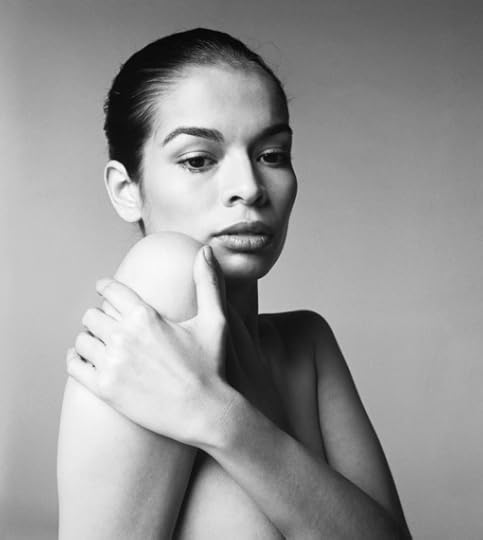
Add to that a painting of a giant red skull and a depiction of The Last Supper, and you have a collection of images that reflect on how even the immortal die, though their image lives on.
Given their shared subject matter, and their shared focus on portraiture, it's quite extraordinary that this is the first major exhibition to pair works by Avedon and Warhol. But it is. And please don't miss it. It's a stunning, exciting yet insightful and reflective exhibition.
Gagosian Gallery, 6-24 Britannia Street, London to April 23, 2016
Admission Free
Image Credits:
1.Andy Warhol, Liza Minnelli, 1979. The Andy Warhol Museum, Pittsburgh. Founding Collection, Contribution Dia Center for the Arts Museum © 2015 The Andy Warhol Foundation for the Visual Arts, Inc. / Artists Rights Society (ARS), New York
2.Richard Avedon, Louis Armstrong, musician, Newport Jazz Festival, Newport, Rhode Island, May 3, 1955. Photograph by Richard Avedon © The Richard Avedon Foundatio
3.Andy Warhol, Tina Freeman, 1975. Private collection © 2015 The Andy Warhol Foundation for the Visual Arts, Inc. / Artists Rights Society (ARS), New York
4.Richard Avedon, Bianca Jagger, actress, Hollywood, CA, January 25, 1972. Photograph by Richard Avedon © The Richard Avedon Foundation
Published on February 12, 2016 08:49
February 9, 2016
Fascinating Leonardo da Vinci Exhibition Opens at Science Museum

Pioneer. Polymath. Genius.
Leonardo's reputation is so profound that it has become hard to separate the man from the myth. Well, this major new exhibition at the Science Museum, Leonardo da Vinci: the Mechanics of Genius, aims to look behind the legend and examine this artist-engineer's enduring reputation.
In addition to his famous paintings, Leonardo was also a gifted draughtsman. There are as many scientific and engineering drawings in his work as there are artistic ones. He seemed as fascinated by gears, chains and springs, as he was by ideal beauty. Leonardo was a man with an almost insatiable appetite for knowledge and this exhibition demonstrates the breadth of that interest beautifully.
However, one of the central challenges with any exhibition on Leonardo though is, well, you don't really have many original exhibits to work with. Few of his works remain, and those that do are rarely, if ever, loaned.
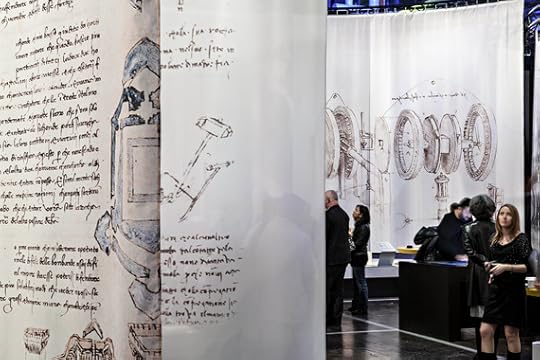
And as for his drawings, they often stayed just that - drawings. They were his observations, his ideas, the results of his studies. So how do you bring all these ideas to life in a compelling exhibition?
Well, the Science Museum has brilliantly tackled that challenge with a blend of both interactive displays that interrogate his radical drawings, and a series of historical models that were made in Milan in 1952 in celebration of the 500th anniversary of Leonardo's birth.
The 39 models display the ingenuity of Leonardo's thinking - submerged forts, diving apparatus, spinning wheels, and (of course) his famous flying machine. Whereas the interactive displays guide you through pages and pages of his notebooks, which he filled with drawings of everything from theatrical sketches to grotesque apocalyptic visions, from methodical observations of nature to monsters and violent imagery.
And, of course, this includes his anatomical drawings.
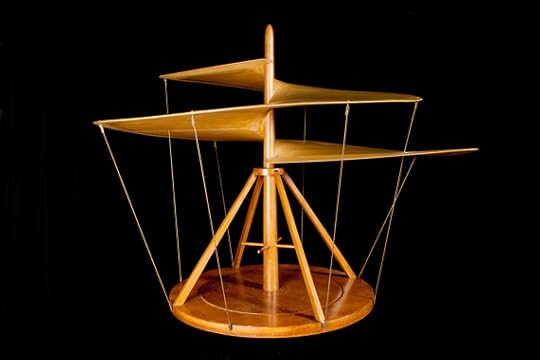
Claim what you want about the great man but, simply, Leonardo created anatomical drawing. He was the first and, frankly, remains the greatest ever anatomical drawer. Prior to him, anatomy was explained through text. But when you can draw like Leonardo (not that anyone else can) of course the opportunity to explain the human anatomy visually was grabbed.
Leonardo attended many dissections yet, remarkably, his impressive drawings were completed from memory after the event. Included in the display are copies of his sketches of the human heart and of foetuses - items we only see now through scientific scanning. His anatomical drawings were unmatched for centuries.
Like many engineers then and now, Leonardo looked to nature for many of his ideas. For example, the familiar spiral corkscrew-style to his flying machine draws on the helical forms found in nature, such as maple, elm or ash seeds. And his sketches of mechanical wings were derived from his observation of birds.
And all this is demonstrated beautifully in this exhibition against the elegant backdrop of Leonardo's masterpieces printed on to partitions and sheer drapes.
This is a fascinating exhibition. And it's interesting that even when you set aside the hyperbole and examine the man's work, you still find yourself a little in awe of this man who blended his radical thinking with a prodigious talent. He really was a one-off.
Science Museum, London to September 4, 2016
Admission: £10. Concessions available.
Image Credits:
1.Exhibition views © EPPDCSI - Ph Levy
2.Exhibition views © EPPDCSI - Ph Levy
3.Aerial Screw © Archivio Museo Nazionale della Scienza e della Tecnologia Leonardo da Vinci - Alessandro Nassiri
Published on February 09, 2016 07:49
January 26, 2016
Stunning New Impressionist Art Exhibition at Royal Academy of Arts

The Royal Academy of Arts' new blockbuster exhibition Painting the Modern Garden: Monet to Matisse, is a triumph. It examines the role gardens played in Impressionist art and, rightly, frames this genre as radical and innovative.
The art here is unquestionably beautiful, yes, but the subject matter wasn't picked by Monet and his contemporaries for prettiness alone. We go to gardens for solitude, for relaxation, for peace and for reflection. This was, therefore, as much an interrogation of man's emotional state as well as an excuse to experiment with bold colour palettes and challenging compositions.
Yet even more than this, the end of the 19th century and early 20th century was an era of rapid industrialisation and, eventually, war. In this context, the subject matter of gardens reflected a need, a direction, for man to remain connected to nature, to the Earth.
The exhibition is dense with masterpieces - Manets and Monets, Klimt and Van Gogh, Sargent and Munch, Renoir and Pissarro, Bonnard and Vuillard, Cassatt and Cezanne..... The list of artists of considerable repute with works on display here is eye-watering. And these are works drawn from collections the world over - private as well as from international galleries.

And plaudits have to go to the curatorial team at the RA who have taken great effort in the lay out of the exhibition. The galleries investigate different types of gardens - as well as Monet's diligently designed Giverny, there's Renoir's exploration of more wild, unmanicured gardens. And we're not limited to French gardens either - John Singer Sargent looks at the Cotswolds, Kroyer takes us to the gardens of Denmark, whilst Sorolla looks at the impact of the baking Spanish sun.
Effort has been made even for the galleries themselves to reflect gardens, with a wonderful cloistered effect mid-way through and garden benches taking the place of more traditional gallery seating.
There is so much to admire here, from the tranquility of Monet's water lilies to Caillebotte's mastery of light and shadow, from the bright vivid hue of Sargent's Poppies, 1886, to the cooling shade of Liebermann's Birch Avenue, 1918; from Monet's lush carpet of purple violets to the scorching sun that bleaches the canvas in Nordstrom's Gardens at Grez, 1884.
And what Monet and his contemporaries started, the Post-Impressionists, the Avant-Garde and the Expressionists responded to and developed.
Van Gogh's garden is almost brutal in its simple, pared down design, whereas the brilliant colours and bold brushstrokes of Nolde's Flower Garden, 1922, and Kandinsky's Murnau Garden II, 1910, take your breath away.

Yet for all the beauty, there is a powerful emotional punch in this show and it comes, as it should, just as the exhibition draws to a close.
Monet's weeping willows were his response to the First World War, painted in the wake of the Battle of the Somme. These mournful paintings hang together in the dim light of the penultimate room. Their branches heavy, their colours muted. These are powerful paintings.
And then, if it's possible for there to be a jewel in this already sparkling crown, the exhibition keeps its best for last. Monet's extraordinary Agapanthus Triptych dominates the final room - its three vast panels hung together to create a panoramic view. Never before have these monumental works been seen in the UK, their permanent residence being the Musée de l'Orangerie in Paris. It is a stunning finale to a stunning exhibition.
Royal Academy of Arts, London to April 20, 2016
Admission £17.60 (£16 without Gift Aid donation). Concessions available.
Image Credits:
Claude Monet, Nympheas (Waterlilies), 1914-15. Oil on canvas, 160.7 x 180.3 cm. Portland Art Museum, Oregon. Museum Purchase: Helen Thurston Ayer Fund, 59.16 © Portland Art Museum, Portland, Oregon.
Wassily Kandinsky, Murnau The Garden II, 1910. Oil on cardboard, 67 x 51 cm. Merzbacher Kunststiftung. Photo © Merzbacher Kunststiftung.
Joaquin Sorolla, Louis Comfort Tiffany, 1911. Oil on canvas, 150 x 225.5 cm. On loan from the Hispanic Society of America, New York, NY. Photo © Courtesy of The Hispanic Society of America, New York.
Published on January 26, 2016 11:40
January 19, 2016
Saatchi Gallery Opens New Show on Female Artists Only
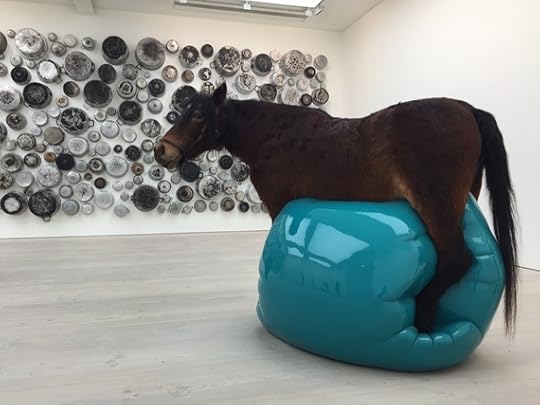
Champagne Life is the first ever exhibition at the Saatchi Gallery showcasing works solely from female artists. The gallery is getting a lot of coverage for this (though the Tate Modern has been doing an impressive job for a while now in showcasing female artists). So, why now?
Wanting to be play catch-up? Possibly. Tokenism? Maybe. Certainly we'd be well within our rights to be pretty cynical about why Charles Saatchi might want to be seen platforming women all of a sudden. But don't let this sway you from visiting as within Champagne Life is some terrific work from female artists who still do not have the visibility of their male counterparts.
The show opens with the eye-catching and accessible canvases from Julia Wachtel. Her subversion of tabloid images of red carpet actresses - with their identikit slim physiques and column dresses - and photos of the pop royalty that is Kim and Kanye is the perfect pop culture commentary to open with. They have easy appeal. Their subject matter, well, it's current, it's relevant and it draws you in.
A smart curatorial approach.
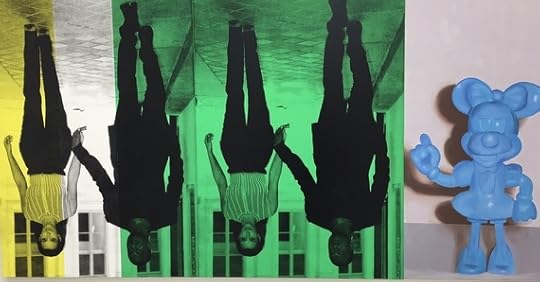
And it's followed with a colourful gallery dedicated to the vivid paintings of Sigrid Holmwood. Her neon washes are bright and loud, keeping the energy of the show going. However, her subject matter is more the romanticised view of Swedish traditional life than Hollywood. Here it's mother and child in basic huts, church boats floating down rivers.... It's an idealised view of the past and the works may not be the strongest in the exhibition, but the blend of the old with the new is an approach used by others on show.
Mequitta Ahuja's exploration of heritage to interrogate the contemporary is an exhibition highlight. Blending inspiration from ancient mythological works and legends, Mequitta's towering paintings bring women to the fore.
With her fearless warriors and bold blue goddesses, Mequitta draws from her African American and Asian Indian roots to depict a female identity that is both modern yet rooted deeply in our past. It's exhilarating stuff. You feel a surge of empowerment just staring at these works.

As well as pictorial works, there's plenty of space set aside in Champagne Life for sculptural works too.
The magical realism from Soheila Sokhanvari will delight - her taxidermied pony perched precariously on a jesmonite blob an eye-catching piece - and the scale and detail of Alice Anderson's copper thread work, Bound and 181 Kilometres, will impress.
But there's also reflection and psychological examination.
Virgil's Ittah's wax sculptures of two bodies suspended between life and death are smartly exhibited alongside Jelena Bulajic's hyper-realistic paintings of very old women. Together these works make for a sobering reflection on mortality, emphasised with this room being an austere and sobering wash of white compared to the colours in the other galleries.
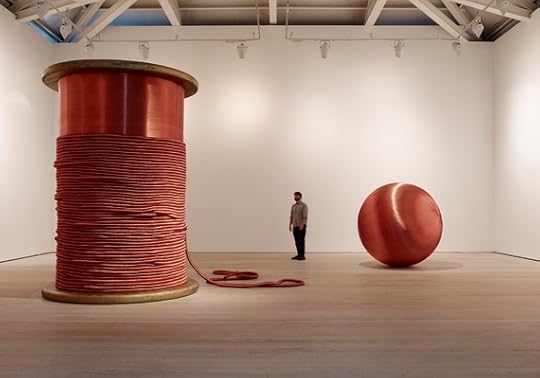
And Maha Malluh's Food for Thought installation of hundreds of cooking pots traditionally used throughout the Arab world is a sad reminder that a woman's work is never done.
That's not to say that everything in this exhibition works flawlessly - Marie Angeletti's representation of the information overload of our internet culture as a series of scrambled images is a smart idea but the finished pieces are confusing and don't quite make the desired impact.
Similarly, Suzanne McClelland's examination of domestic terrorists in the US screams an immediately relevant subject matter, but here too, the finished works are quite inaccessible and opaque, seemingly little more than graffitied monochrome canvases.
But nevertheless, every single artist on show here brings something to the table that is challenging and thought-provoking. Some of it may not be finely honed but it is a great diverse collection from a wide range of female artists, all of whom have something to say. And what they're saying deserves to be heard.
Saatchi Gallery, London to March 9, 2016
Admission Free
Image Credits:
1. Soheila Sokhanvari, Moje Sabz, 2011, in front of Maha Malluh Untitled (Food for Thought), 2015. Photograph by Victoria Sadler.
2. Julia Wachtel, Champagne Life, 2014. Photograph by Victoria Sadler.
3. Detail from Mequitta Ahuja, Autocartography III, 2012. Photograph by Victoria Sadler.
4. Alice Anderson. Left: Bound 2011 Bobbin made of wood and copper thread 345 x 248 x 248 cm. Right: 181 Kilometers 2015 Sculpture made after performances, copper thread 200 cm (diameter). Image (c) Steve White, 2015. Courtesy of the Saatchi Gallery, London
Published on January 19, 2016 12:41
January 13, 2016
Theatre Review: Les Liaisons Dangereuses, Donmar Warehouse Still Resonates

Les Liaisons Dangereuses really is such a terrific play. Christopher Hampton's adaptation of Choderlos de Laclos' novel is just so good - full of passion, intrigue, betrayal, loss and gender politics. And all these themes wrapped within this well-known story of a pair of schemers in pre-Revolutionary France.
Marquise de Merteuil (Janet McTeer) and her former lover, Vicomte de Valmont (Dominic West) pass their time sabotaging the love and relationships of those unfortunate enough to cross their paths in French high society.
The latest game is set by the Marquise - she wants Valmont to corrupt the innocent Cecile de Volanges (Morfydd Clark), who is about to be married, simply because Cecile's fiancé is an ex-lover of the Marquise. Valmont though doesn't see this as much of a challenge, preferring instead to go for the virtuous and married Madame de Tourvel (Elaine Cassidy).
Slightly put out that Valmont may have interests elsewhere, the Marquise adapts her proposal to ensure both she and Valmont get what they want - and that Valmont does not replace the Marquise at the top of his list with someone else.
But of course, none of this is going to end well.
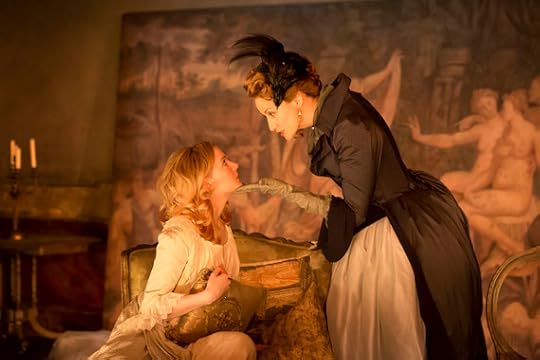
This production at the Donmar has all the tight bodices, powdered wigs and huge chandeliers you could hope for. Yet this is a clever set design from Tom Scutt as these chateaus and their inhabitants start off covered with plastic dust sheets, paint flaking off from the crumbling walls and the paintings shoved up against the walls.
This is history coming to life. This is a story from the past, memories, lessons coming back to remind us.
Janet McTeer is glorious as the scheming Marquise. Positively luminous. She oozes malevolence and dangerous insincerity. Her interpretation may not be overtly sexual but this is an impressive performance that perfectly captures a tender fragility as the Marquise realises she is playing a game with something and someone that she can't bear to lose.
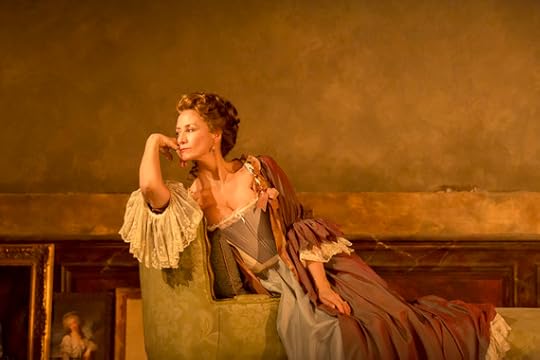
Sadly though I didn't feel she was matched by Dominic West as Valmont. He was still fluffing his lines, though we are quite a way into the run now. But more fundamentally I wasn't sure that this was a Valmont that gripped and menaced.
Here, Valmont is played as a swaggering cad, and so there was none of that Machiavellian spirit which Valmont should exude. Here he's more Jack the lad. Valmont should be sinister, threatening even. Here he's more your quintessential 'bad boy,' which doesn't really work.
As a result, there is a lack of chemistry between these two schemers that does draw the delicious poison out from this production somewhat.
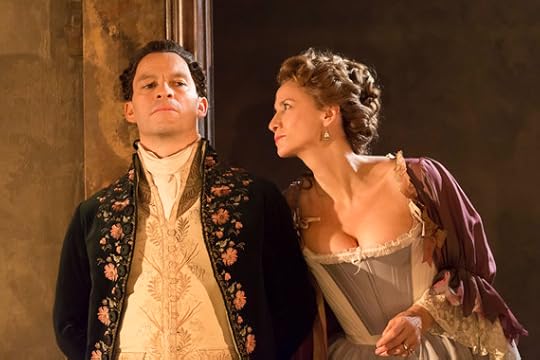
But what excited me most was just how bitingly relevant the gender politics in the writing remains. Yes, these women are restrained by the assigned gender roles of 18th century France but, tell me, has this changed much?
And clearly director Josie Rourke agrees that little has moved on as there was a knowing relevance in the Marquise's outburst that the promiscuity that society exalts and applauds in men is condemned and shamed in women. Just as true today. Time moves on, empires rise and fall, yet still nothing changes for women.
That's not to say that this play isn't without its challenges for modern audiences. Most notably the scene where Valmont 'seduces' Cecile. Fresh out the convent, Cecile is completely out of her depths in French society, let alone as a plaything in the Marquise's and Valmont's games.
This seduction scene is, at best, sexual assault. At worst, this is rape. Yet somehow, by the end of the scene, we have to get to the conclusion that Cecile likes sex.
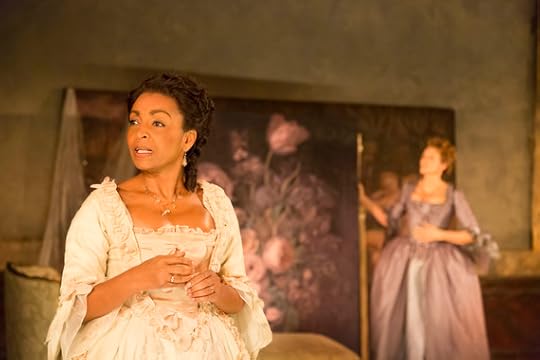
This is an undeniably tricky scene and it's not an easy one to watch. My anxiety wasn't helped by guffaws of laughter from many in the audience. But credit to Josie Rourke, this scene is not played for laughs at all (I'll charitably conclude that many in the audience were perhaps laughing because they felt uncomfortable. Perhaps).
What makes this scene (just about) bearable is a perfectly pitched performance from Morfydd Clark whose Cecile is nuanced and conflicted enough to make this work.
This is a great revival of a terrific play with much in its message that still (sadly) resonates 30 years after it first opened.
Les Liaisons Dangereuses is sold out for the rest of its run, with only returns and the mad dash that is the weekly Barclays Front Row lottery as the options available to get tickets. However this will be broadcast live in cinemas in partnership as part of NT Live on 28 January 2016.
Donmar Warehouse, London to February 13, 2016
Image Credits:
1.Janet McTeer (La Marquise de Merteuil) and Dominic West (Le Vicomte de Valmont) in Les Liaisons Dangereuses at the Donmar Warehouse - photo by Johan Persson
2.Morfydd Clark (Cecile Volanges) and Janet McTeer (La Marquise de Merteuil) in Les Liaisons Dangereuses at the Donmar Warehouse - photo by Johan Persson
3.Janet McTeer (La Marquise de Merteuil) in Les Liaisons Dangereuses at the Donmar Warehouse - photo by Johan Persson
4.Dominic West (Le Vicomte de Valmont) and Janet McTeer (La Marquise de Merteuil) in Les Liaisons Dangereuses at the Donmar Warehouse - photo by Johan Persson
5.Adjoa Andoh (Madame de Volanges) in Les Liaisons Dangereuses at the Donmar Warehouse - photo by Johan Persson
Published on January 13, 2016 11:00
January 5, 2016
Gathered Leaves: Alec Soth's Photography of Contemporary America
Alec Soth is one of America's most celebrated contemporary photographers and this new exhibition at the Science Museum is his first major UK show.
It's a rare opportunity to see a survey of Alec's career to date as it brings together work from four of his most celebrated projects, focused on the United States, that, together, show many sides of a country and a population looking to find their place in a world of constant challenges.

The display opens with Sleeping by the Mississippi (2004), a romantic collection of photos of individuals and locations that evolved from a series of road trips Alec took along the 2000 mile course of this iconic river.
There's no particular driving narrative to this collection of photos. There's the minister's wife clutching her treasured photograph of angel (more an unusual cloud formation to the likes of you and me), the woman in New Orleans displaying the cross that has been pressed into her forehead as part of an Ash Wednesday ceremony, and the shots of Johnny Cash's boyhood home in Arkansas.
But you sense a collective identity in these photos of the Midwest. There's nothing particularly wild or exotic about this landscape - it is a reflection of real life.
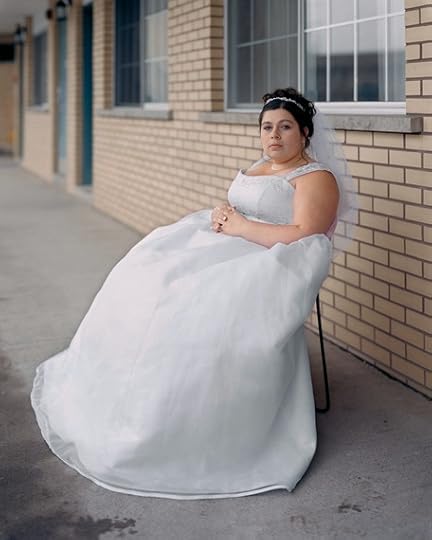
Niagara (2006) sees a more explicit exploration of the reality gap in the American Dream. Here, shots of happy brides and the stunning waterfalls of this famous location are contrasted with its run-down motels and handwritten notes from the broken-hearted. The romantic idyll contrasted with reality.
A personal favourite in this collection was Cadillac Motel, 2005, of one track of footprints in deep snow that lead to the door of Room No.17. No second pair of prints, no track of steps leaving the room. Who knows what is going on behind that door?
Broken Manual (2010) is the darkest of the four projects on show. Here, Alec set himself the task of getting a glimpse into the lives of some of the men who lead almost hermit-style lives in the forests and mountains across the United States.

The project began with Alec researching Eric Robert Rudolph, the bomber behind a string of attacks on abortion clinics and the Atlanta Olympics in the 1990s. But the project expanded to record the reclusive lives of many of those who had chosen to withdraw from civil society, such as radicals, monks and hermits.
As you look at these photos of these loners, men who live so separate from society, you sense sympathy from Alec. Does he feel kinship with them? Does he identify with their desire to be isolated and alone?
This is a very introspective and intense collection of work - portraits in the American wilderness juxtaposed with intriguing shots of their habitat, such as a solitary glitterball hanging from a branch in a dense forest.
The exhibition closes with the first UK showing of Alec's highly-acclaimed latest project, Songbook (2014). This body of work sees Alec emerge from the isolation of Broken Manual and embrace a project that took him across seven states, capturing images from a myriad of communal gatherings, including dances, festivals and meetings.

The photography is all black and white and, in contrast to his previous project, Songbook looks at our need to be part of a community, to be part of something bigger and more meaningful than just ourselves.
There's dancing, parties, beauty pageants and cheerleaders. Yet it's the anxiety that we may be failing in this that comes across most - a standout image being one taken at Facebook in Menlo Park, California of a solitary man crossing a vast, deserted cement park. A picture that speaks more than 1000 Likes.
This show covers a huge scope of work that cuts to the heart of who we are and what we're looking for - and comes back with more questions than answers. Impressive, wonderful and quite beautiful.
Science Museum, London to March 28, 2016
The exhibition will then travel to:
���National Media Museum, Bradford, from 22 April to 26 June 2016
���Finnish Museum of Photography, Helsinki from 17 August to 30 October 2016
���FotoMuseum Antwerp, Belgium from 17 February to 4 June 2017
Image Credits:
1. Adelyn, Ash Wednesday, New Orleans, Louisiana, 2000, from Sleeping by the Mississippi © Alec Soth
2. Melissa, 2005, from Niagara © Alec Soth.jpg
3. Alec Soth exhibition © Kate Elliott, courtesy Science Museum.JPG
4. Bree. Liberty Cheer All-Stars. Corsicana, Texas, 2013, from Songbook © Alec Soth
It's a rare opportunity to see a survey of Alec's career to date as it brings together work from four of his most celebrated projects, focused on the United States, that, together, show many sides of a country and a population looking to find their place in a world of constant challenges.

The display opens with Sleeping by the Mississippi (2004), a romantic collection of photos of individuals and locations that evolved from a series of road trips Alec took along the 2000 mile course of this iconic river.
There's no particular driving narrative to this collection of photos. There's the minister's wife clutching her treasured photograph of angel (more an unusual cloud formation to the likes of you and me), the woman in New Orleans displaying the cross that has been pressed into her forehead as part of an Ash Wednesday ceremony, and the shots of Johnny Cash's boyhood home in Arkansas.
But you sense a collective identity in these photos of the Midwest. There's nothing particularly wild or exotic about this landscape - it is a reflection of real life.

Niagara (2006) sees a more explicit exploration of the reality gap in the American Dream. Here, shots of happy brides and the stunning waterfalls of this famous location are contrasted with its run-down motels and handwritten notes from the broken-hearted. The romantic idyll contrasted with reality.
A personal favourite in this collection was Cadillac Motel, 2005, of one track of footprints in deep snow that lead to the door of Room No.17. No second pair of prints, no track of steps leaving the room. Who knows what is going on behind that door?
Broken Manual (2010) is the darkest of the four projects on show. Here, Alec set himself the task of getting a glimpse into the lives of some of the men who lead almost hermit-style lives in the forests and mountains across the United States.

The project began with Alec researching Eric Robert Rudolph, the bomber behind a string of attacks on abortion clinics and the Atlanta Olympics in the 1990s. But the project expanded to record the reclusive lives of many of those who had chosen to withdraw from civil society, such as radicals, monks and hermits.
As you look at these photos of these loners, men who live so separate from society, you sense sympathy from Alec. Does he feel kinship with them? Does he identify with their desire to be isolated and alone?
This is a very introspective and intense collection of work - portraits in the American wilderness juxtaposed with intriguing shots of their habitat, such as a solitary glitterball hanging from a branch in a dense forest.
The exhibition closes with the first UK showing of Alec's highly-acclaimed latest project, Songbook (2014). This body of work sees Alec emerge from the isolation of Broken Manual and embrace a project that took him across seven states, capturing images from a myriad of communal gatherings, including dances, festivals and meetings.

The photography is all black and white and, in contrast to his previous project, Songbook looks at our need to be part of a community, to be part of something bigger and more meaningful than just ourselves.
There's dancing, parties, beauty pageants and cheerleaders. Yet it's the anxiety that we may be failing in this that comes across most - a standout image being one taken at Facebook in Menlo Park, California of a solitary man crossing a vast, deserted cement park. A picture that speaks more than 1000 Likes.
This show covers a huge scope of work that cuts to the heart of who we are and what we're looking for - and comes back with more questions than answers. Impressive, wonderful and quite beautiful.
Science Museum, London to March 28, 2016
The exhibition will then travel to:
���National Media Museum, Bradford, from 22 April to 26 June 2016
���Finnish Museum of Photography, Helsinki from 17 August to 30 October 2016
���FotoMuseum Antwerp, Belgium from 17 February to 4 June 2017
Image Credits:
1. Adelyn, Ash Wednesday, New Orleans, Louisiana, 2000, from Sleeping by the Mississippi © Alec Soth
2. Melissa, 2005, from Niagara © Alec Soth.jpg
3. Alec Soth exhibition © Kate Elliott, courtesy Science Museum.JPG
4. Bree. Liberty Cheer All-Stars. Corsicana, Texas, 2013, from Songbook © Alec Soth
Published on January 05, 2016 08:01
December 29, 2015
Review: 'Linda', Royal Court Theatre 'Excellence Throughout'
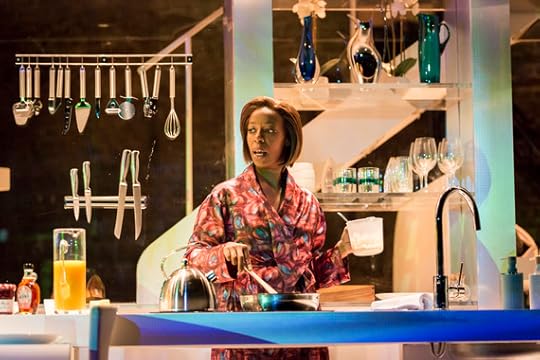
Nobody was talking about Kim Cattrall as we, the audience, filed out of the theatre. Because that was who was originally supposed to be playing Linda in this new play from Penelope Skinner at the Royal Court. Yet only a couple weeks before the show was due to open, Kim had to quit for medical reasons and in her place came Noma Dumezweni.
And now, courtesy of a little old press release on the Harry Potter musical, everyone is talking about Noma. Everyone. So how thrilled I was to catch her here before she becomes huge next year.
And what a performance she gives.

Linda (Noma) is a woman battling to stay current, to stay relevant and, fundamentally, to stay visible.
A woman in her fifties who should be reaping the rewards for a career that has seen her launch a Dove-esque marketing campaign to improve female self-esteem at her skincare company Swan, whilst successfully bringing up two bright children is instead facing terminal decline.
Everywhere she turns, a younger woman is trying to push her off stage.
Her husband is dealing with his mid-life crisis and his fragile masculinity - challenged by being overshadowed by his dynamic wife - by having an affair with a woman young enough to be his daughter. And at work, Linda finds her position imperilled by an ambitious and devious younger woman.
And added to that, her company is abandoning her trailblazing campaign to promote female bodies of all shapes and sizes for a return to more 'aspirational' marketing i.e. the airbrushed images of 20 year olds promoting anti-ageing products are back. (A quite brilliant echo of what has actually happened to the Dove campaign itself).
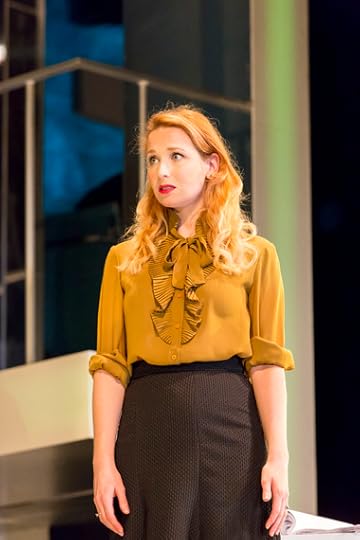
This is a play for our times, for sure. Women-centric and it focuses on many issues that are flowing through current discourse - when women above a certain age are just put out to pasture by society, ignored and overlooked.
This could have been a minefield of clichés, a checklist of concerns that we already know. Yet not only is the writing biting and brilliant, all this is juxtaposed beautifully with Linda's troubled daughter Alice (Karla Crome) who desperately wants to be invisible in her world of online shaming and bullying, peer pressure and the troubling impact of the ever-present male gaze.
It's a wonderful contrast - the mother who desperately wants to be noticed, the daughter who wants to disappear. And both prevented from getting what they want by a sexist society that judges them.
Penelope Skinner certainly packs it all in. Not only are there sub-plots of beauty campaigns, cheating husbands and workplace politics, but the play also has revenge porn, self-harming, double standards on female behaviour, absent parents, and even King Lear references.
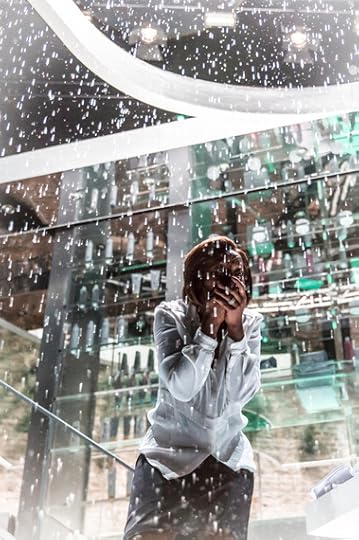
The play is energetic, dynamic and director Michael Longhurst powers it through its 2h40min running time to a highly charged dramatic climax. In fact, the ending is close to being OTT and it's questionable whether such a sensational climax is earned.
But nevertheless, the play smartly brings the two lives of both Linda and Alice full circle with some excellent writing.
In fact, there is excellence throughout this production, from Es Devlin's multi-storey 360 degree revolving set, to each performance from this very talented cast.
But Noma's performance is just, hands down, awesome. She breathes life into Linda. Her delivery is fascinating, and she just oozes charisma as Linda is on the way up - and you feel that sudden shock to her system, the panic and the fear as it all crashes down around her. Her unravelling is perfectly done. A towering central performance in a timely and tightly-plotted play.
Royal Court Theatre, London to January 9, 2016
Image Credits: All photographs by Johan Persson
1. Noma Dumezweni (Linda)
2. Noma Dumezweni (Linda) and Imogen Byron (Bridget)
3. Amy Beth Hayes (Amy)
4. Noma Dumezweni (Linda)
Published on December 29, 2015 05:01
December 20, 2015
The Force Awakens: Rey and the Thorny Issue of 'The Feminist Protagonist'
So this little piece I've written here is a request: please can we ease up on the strong woman/ feminist trope? I ask this as, with all the excitement over the new Star Wars film, The Force Awakens, there has been an awful lot written about how Rey, the new female lead played by Daisy Ridley, is a feminist protagonist.
What does this mean? What on earth is a feminist protagonist? The Atlantic describes it as "no distressing damsel. She's instead a fighter and a survivor and a nurturer and an all-round badass."
And that is Rey, for sure. Interesting qualities, absolutely. Exciting ones too. But these do not make her a feminist.
They wouldn't make anyone a feminist. That's because feminism has nothing to do with how a woman appears or behaves. Female behaviour and personality traits don't relate to feminism - feminism, like any civil rights movement, is something you choose to be a part of.
Feminism is for all women. All. And any attempts to frame certain traits as feminist are dangerous.
Strong, assertive female characters such as Rey are no more feminist than Emma Thompson's character in Love Actually. Ripley from Alien is no more feminist than Daryl Hannah in Splash!
That Rey, like Ripley before her, is unapologetic is terrific. That she takes up space, never shrinking back, is understandably attractive and is bang in line with current discourse.
However, just because a woman is physically strong and athletic, assertive and can handle a lightsaber or a flame thrower, that doesn't necessarily make her a feminist. And, conversely, like Emma Thompson in Love Actually, a woman who has been cheated on by her philandering husband yet chooses to stay with him can, of course, be a feminist.
It would be a mistake and exclusionary to correlate feminism with just a certain type of female behaviour, or dictate that only certain female behaviour is acceptable for a feminist. A strong, independent woman can be as misogynistic as any MRA, and a submissive woman can be feminist to the core.
Sexism includes correlating certain behaviours and traits with gender. Don't think that just by flipping that around 180 degrees we've suddenly got ourselves a feminist icon. What we have is a different type of female character - a welcome change, yes, but let's not correlate that with feminism. Let's not mistake correlating another type of behaviour as acceptable as freeing ourselves from sexism - it's just building women a new cage.
That's not to say Rey isn't welcome. She is, absolutely. It is a big step - and a welcome one - for Star Wars to move away from the Aryan blue-eyed blonde-haired leading male to a young woman.
As a role model for young girls and boys Rey is wonderful. Her spirit and confidence makes a refreshing change from the more typical depiction of women in films. Like Katniss before her, I hope she has a profound subliminal effect on the kids who will flock to see the film.
Variety is crucial (and we're still miles away from that - Rey after all is white and well-spoken) but she is a great step forward.
But she is not a feminist just because she is feisty. I hope she is a feminist, I really do. But as Meryl Streep recently demonstrated, strong women who fight seemingly feminist positions can still turn their backs on feminism.
But more than this, I don't want young girls thinking, I'm not a feminist because I'd rather be Cinderella than Rey. And I don't want boys thinking they should only admire and respect women who are pushy and wilful. And I don't want anyone overlooking or diminishing any woman who doesn't exhibit behaviour or personality traits similar to Rey.
Feminism is for everyone and fights for all young girls and women. All young girls and all women are to be respected. All. Feminism is not exclusively for the 'badass.'
That not all women consider themselves feminists is unfortunate but nevertheless, let's not reduce feminism to a Charlie perfume advert. As feminists, we love our 'strong women'. But not to the exclusion of women who don't share those traits.
What does this mean? What on earth is a feminist protagonist? The Atlantic describes it as "no distressing damsel. She's instead a fighter and a survivor and a nurturer and an all-round badass."
And that is Rey, for sure. Interesting qualities, absolutely. Exciting ones too. But these do not make her a feminist.
They wouldn't make anyone a feminist. That's because feminism has nothing to do with how a woman appears or behaves. Female behaviour and personality traits don't relate to feminism - feminism, like any civil rights movement, is something you choose to be a part of.
Feminism is for all women. All. And any attempts to frame certain traits as feminist are dangerous.
Strong, assertive female characters such as Rey are no more feminist than Emma Thompson's character in Love Actually. Ripley from Alien is no more feminist than Daryl Hannah in Splash!
That Rey, like Ripley before her, is unapologetic is terrific. That she takes up space, never shrinking back, is understandably attractive and is bang in line with current discourse.
However, just because a woman is physically strong and athletic, assertive and can handle a lightsaber or a flame thrower, that doesn't necessarily make her a feminist. And, conversely, like Emma Thompson in Love Actually, a woman who has been cheated on by her philandering husband yet chooses to stay with him can, of course, be a feminist.
It would be a mistake and exclusionary to correlate feminism with just a certain type of female behaviour, or dictate that only certain female behaviour is acceptable for a feminist. A strong, independent woman can be as misogynistic as any MRA, and a submissive woman can be feminist to the core.
Sexism includes correlating certain behaviours and traits with gender. Don't think that just by flipping that around 180 degrees we've suddenly got ourselves a feminist icon. What we have is a different type of female character - a welcome change, yes, but let's not correlate that with feminism. Let's not mistake correlating another type of behaviour as acceptable as freeing ourselves from sexism - it's just building women a new cage.
That's not to say Rey isn't welcome. She is, absolutely. It is a big step - and a welcome one - for Star Wars to move away from the Aryan blue-eyed blonde-haired leading male to a young woman.
As a role model for young girls and boys Rey is wonderful. Her spirit and confidence makes a refreshing change from the more typical depiction of women in films. Like Katniss before her, I hope she has a profound subliminal effect on the kids who will flock to see the film.
Variety is crucial (and we're still miles away from that - Rey after all is white and well-spoken) but she is a great step forward.
But she is not a feminist just because she is feisty. I hope she is a feminist, I really do. But as Meryl Streep recently demonstrated, strong women who fight seemingly feminist positions can still turn their backs on feminism.
But more than this, I don't want young girls thinking, I'm not a feminist because I'd rather be Cinderella than Rey. And I don't want boys thinking they should only admire and respect women who are pushy and wilful. And I don't want anyone overlooking or diminishing any woman who doesn't exhibit behaviour or personality traits similar to Rey.
Feminism is for everyone and fights for all young girls and women. All young girls and all women are to be respected. All. Feminism is not exclusively for the 'badass.'
That not all women consider themselves feminists is unfortunate but nevertheless, let's not reduce feminism to a Charlie perfume advert. As feminists, we love our 'strong women'. But not to the exclusion of women who don't share those traits.
Published on December 20, 2015 10:15
December 9, 2015
Top 15 London Art Shows to See in 2016
2015 was a great year for art shows in the capital, with high-profile solo artist shows, such as Ai Weiwei at the Royal Academy, John Singer Sargent at the National Portrait Gallery and Goya at the National Gallery, sitting perfectly alongside genre and subject-focused exhibitions, such as post-war British cultural history at Hayward Gallery, and non-Anglo-American Pop Art at Tate Modern.
That blend continues into 2016, along with the platforming of diverse artists, showcasing works from those who are not household names, alongside those who most definitely are. There is plenty to look forward to.
1. Georgia O'Keeffe, Tate Modern
(July 6 - October 30, 2016)

A founding member of American modernism, this show on Georgia O'Keeffe will chart the full length of Georgia's career, from her early experimental abstract work to the development of her iconic style. It has been over 20 years since the UK last saw such a large-scale survey of the work of this influential artist. In the experienced hands of Tate Modern, there is little, if any, chance this show will disappoint.
2. Botticelli Reimagined, Victoria & Albert Museum
(March 5 - July 3, 2016)
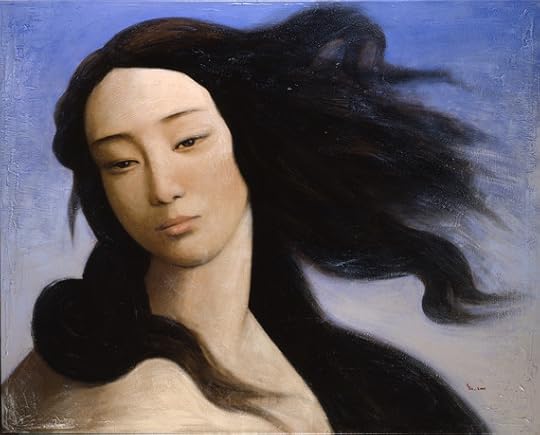
The largest Botticelli exhibition since 1930, this show will examine the legacy of this great artist. With an extraordinary range of exhibits that will include paintings, fashion, film, photography, tapestry, sculpture and prints, the show will explore how artists have reinterpreted his work. The show will bring together an impressive collection of 50 of Botticelli's works and, shown alongside these, will be works from Andy Warhol, René Magritte and Dante Gabriel Rossetti, among others.
3. Mona Hartoum, Tate Modern
(May 4 - August 21, 2016)

Tate Modern really led the way in 2015 with its platforming of female artists - and the shows on Marlene Dumas, Sonia Delaunay and Agnes Martin were amongst the year's highlights. That spirit is being carried into 2016 and I've high hopes for this, the first ever survey of the work of Mona Hartoum, one of the most important artists working today.
Born in Beirut in 1952 to a Palestinian family, Mona came to London in 1975 after war broke out in Lebanon. This exhibition will present over 100 of her works, from the 1980s to the present day, and will reflect her dynamic use of a vast range of media including performance and video, sculpture, installation, photography and works on paper. You'll have to drag me out of this one.
4. Abstract Expressionism, Royal Academy of Arts
(September 24, 2016 - January 2, 2017)

Names such as Jackson Pollock, Mark Rothko and Willem de Kooning are well-established but, incredibly, this will be the first major collective exhibition of Abstract Expressionism in the UK in over 50 years.
It's an exhibition that excites in its scale and ambition - the show will feature over 100 works and will explore the myth of homogeneity in this movement, considering different strands where some artists such as Rothko expressed their art through large single expanses of colour, whereas others such as Pollock employed more spontaneous mark-making. The spacious galleries of the RA seem the ideal venue.
5. The Vulgar, Barbican Centre
(October 13, 2016 - February 5, 2017)
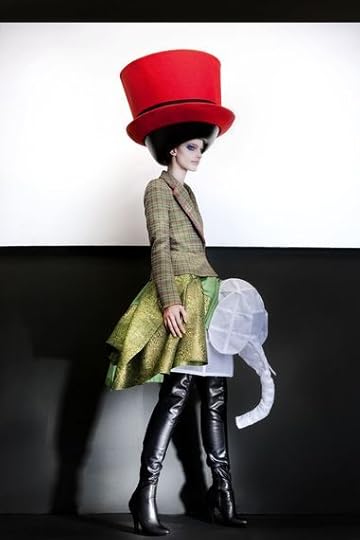
Now this one I am really looking forward to. What is vulgar? What role does 'taste' have in art - and how has that changed and developed over time? These are the provocations thrown down here and it's a subject that will be investigated through works from the Renaissance to the 21st century, in exhibits including historical costumes, couture, high street fashion, manuscripts, photography and film.
6. Beyond Caravaggio, National Gallery
(October 12, 2016 - January 15, 2017)
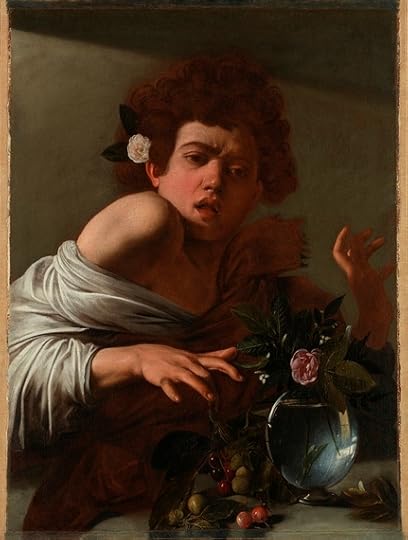
Ah, Caravaggio. A master in every way possible - the composition, the naturalism, the drama, the lighting.... It's all there. So how exciting that the National Gallery is devising this exhibition that will examine his legacy and influence on the work of artists that followed.
However, this could obviously go two ways - there is always the risk that the other works will pale in comparison, much as what happened with a similar attempt by the RA this year to explore the legacy of Rubens. The 50 works that will be curated together for this show will largely come from National Trust houses and private collections, so will be unfamiliar to many. We wait and see.
7. Russia and the Arts: The Age of Tolstoy and Tchaikovsky, National Portrait Gallery
(March 7 - June 26, 2016)

An unprecedented cultural exchange with Moscow will result in this exhibition of portraits of key figures from a golden age of the arts in Russia. The State Tretyakov Gallery will lend the NPG some of Russia's most highly treasured portraits including those of Chekhov, Dostoevsky, Tchaikovsky, Tolstoy and Turgenev, whilst, in return, London will loan portraits of Dickens, Wollstonecraft, Elizabeth I, Darwin and Shakespeare.
Russia and the Arts will cover the years between 1867 and 1914 when Russian art, literature and music were in a period of unprecedented success - an era that would be cut short by war and revolution.
8. Easter Rising 1916, The Photographers' Gallery
(January 22 - April 3, 2016)
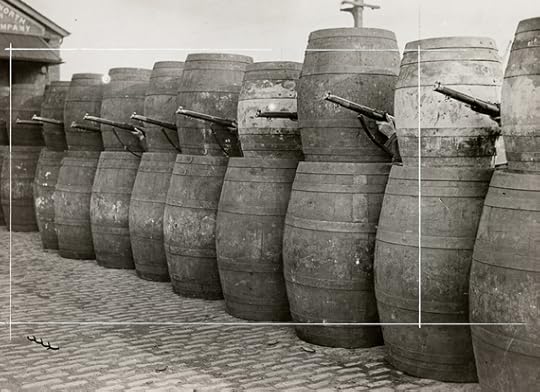
Next year is the centenary of the 1916 Rebellion, a huge insurrection from Irish Republicans as they attempted to end British rule. The rebellion was crushed by the British Army but at a terrible cost, with almost 500 killed, over half of whom were civilians. And though defeated, the event led to a surge in support for direct action in the Republican movement.
What's interesting about the photographs brought together for this show though is, in addition to the events they covered, many of the scenes were staged, enabling the viewer to explore issues of authenticity and manipulation. Or to wonder whether this even matters in a world where all reporting had a British bias.
9. Hockney Portraits, Royal Academy of Arts
(July 2 - October 2, 2016)
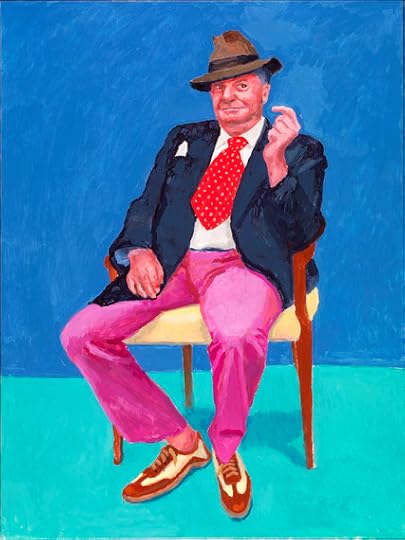
The smaller Sackler Wing galleries in the RA have hosted some gems in the last few years and this promises to follow in that path. This show will be solely of David Hockney's portraits that he has completed over the last few years, each portrait painted on the same sized canvas (48 x 36 inches), each sitter posed in the same chair, and set against the same blue background. Can't wait.
10. Conceptual Art in Britain 1964-75, Tate Britain
(April 12 - August 29, 2016)

Sometimes exhibitions trip over themselves trying to do too much, which is why I'm excited that this show will explore a very specific 11 year period that was critical in the development of a movement that was profoundly influential on later generations of artists. Such a narrow focus may well lead to great results, especially as it will include works from artists critical to to British conceptual art, such as Michael Craig-Martin, Keith Arnatt, Victor Burgun, and Art & Language.
11. Delacroix and the Rise of Modern Art, National Gallery
(February 17 - May 22, 2016)

Incredibly, this will be the first exhibition of Delacroix's work in Britain for more than 50 years. And more than this, the exhibition will also investigate Delacroix's influence on artists who came after him. More than a third of the display will be of Delacroix's paintings, including impressive loans such as Self-Portrait from Musee du Louvre, and Convulsionists of Tangiers from Minneapolis Institute of Art. And the exciting loans don't stop there for included in the works will be examples of his influence on masterpieces such as Van Gogh's Pieta (after Delacroix) from Amsterdam, and Cezanne's Battle of Love from Washington.
12. Robert Rauschenberg, Tate Modern
(December 1, 2016 - April 2, 2017)
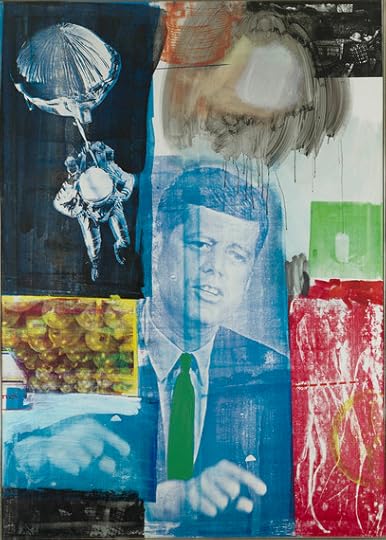
The highlight of the Autumn season at Tate Modern promises to be this first posthumous retrospective on the work of Robert Rauschenberg. This exhibition is a dual effort with MoMA and will span the length of Robert's long career, with important works on display from each phase of his work. This will include a selection of his stunning Combines - hybrids between painting and sculpture - and some of his graphic screen prints of the assassination of President Kennedy, which signalled Robert's early commitment to political activism.
13. Paul Nash, Tate Britain
(October 26, 2016 - March 5, 2017)
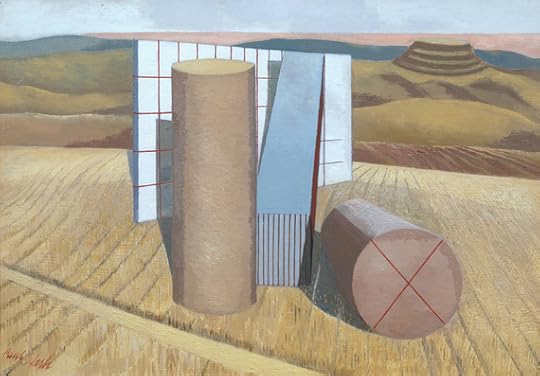
One of the most important British artists of the 20th century, Paul Nash's work is distinctive and made him a key figure in the development of Modernism in British art. His focus was on landscapes, often incorporating elements of ancient history in his works, and no doubt this show will demonstrate how his style developed over the years into an increasingly abstract and surreal style.
14. Strange and Familiar: Britain as Revealed by International Photographers, Barbican Centre
(March 16 - June 19, 2016)

From social documentary and street photography, to portraiture and architectural photography, this expansive exhibition will examine Britain from the 1930s onwards. But with a twist - none of the photographers included in the show are British.
The show is being curated by Martin Parr and promises to be a fascinating insight into what interested and concerned photographers such as Henri Cartier-Bresson (France), Robert Frank (USA) and Edith Tudor-Hart (Austria) as they viewed Britain as a foreign country.
15. Painting the Modern Garden: Monet to Matisse, Royal Academy of Arts
(January 30 - April 20, 2016)
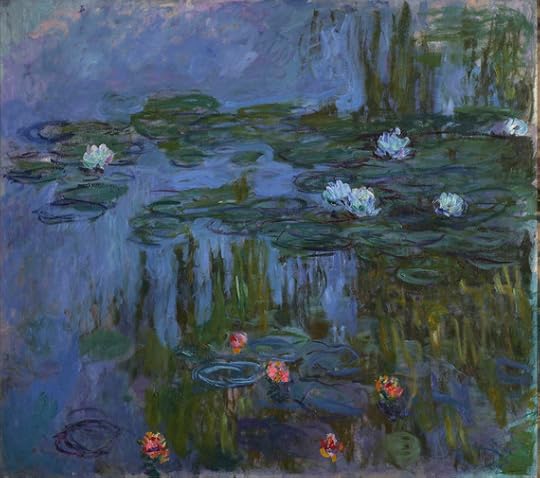
This show hasn't even opened yet and it's already ruffling feathers. This show will look at the role of gardens in Impressionist, Post-Impressionist and Avant-Garde art and, truthfully, these aren't genres that lack for platforming. Perhaps the RA could have showcased other artists and genres but, such is the popularity of Monet, Cezanne, Pissarro and Manet, the crowds are sure to arrive.
And the RA does have a trump card up its sleeve as this exhibition will have Monet's great Agapanthus Triptych from the Musee de l'Orangerie on display - the first time these will have been shown in the UK.
Image Credits:
1.Georgia O'Keeffe Abstraction White Rose, 1927, Oil on canvas, 36 x 30 (91.4 x 76.2) Georgia O'Keeffe Museum. Gift of The Burnett Foundation and Georgia O'Keeffe Foundation. © Georgia O'Keeffe Museum
2.Venus, after Botticelli, artist: Guillaume Duhamel, Date: 2008 by Yin Xin © Private collection, courtesy Duhamel Fine Art, Paris
3.Mona Hatoum, Cellules (detail), 2012-2013 © Courtesy of the artist and Galerie Chantal Crousel, Paris © Photo Sébastien Normand
4.Jackson Pollock, Male and Female, 1942-43, Oil on canvas, 186.1 x 124.5 cm, Philadelphia Museum of Art. Gift of Mr. and Mrs. H. Gates Lloyd, 1974. Photo Philadelphia Museum of Art © Courtesy of The Pollock-Krasner Foundation ARS, NY and DACS, London 2015
5.The Vulgar: Walter Van Beirendonck FW 2010/2011 © Ronald Stoops
6.Michelangelo Merisi da Caravaggio, Boy bitten by a lizard, 1595-1600 © The National Gallery, London
7.Anna Akhmatova by Olga Della-Vos-Kardovskaia, 1914 © State Tretyakov Gallery, Moscow
8.Barricade made from barrels, 1916 © Sean Sexton Collection. Courtesy of the Sean Sexton Collection.
9.David Hockney, Barry Humphries, 26-28 March, 2015, Acrylic on canvas, 121.92 x 91.44 cm © David Hockney. Photo credit: Richard Schmidt
10.John Hilliard, Camera Recording its Own Condition (7 Apertures, 10 Speeds, 2 Mirrors), 1971. Presented by Colin St John Wilson 1980, Tate © John Hilliard
11.Eugène Delacroix Self Portrait, about 1837, Oil on canvas 65 x 54.5 cm, Musée du Louvre, Paris (RF 25) © RMN-Grand Palais (musée du Louvre) / Jean-Gilles Berizzi
12.Robert Rauschenberg Retroactive I, 1963 Wadsworth Atheneum, Hartford, Connecticut. Gift of Susan Morse Hilles
13.Paul Nash Equivalents for the Megaliths, 1935 ©Tate
14.Cas Oorthuys London, 1953 © Cas Oorthuys / Nederlands Fotomuseum
15.Claude Monet, Nympheas (Waterlilies), 1914-15, Oil on canvas, 160.7 x 180.3 cm, Portland Art Museum, Oregon. Museum Purchase: Helen Thurston Ayer Fund, 59.16 © Portland Art Museum, Portland, Oregon
That blend continues into 2016, along with the platforming of diverse artists, showcasing works from those who are not household names, alongside those who most definitely are. There is plenty to look forward to.
1. Georgia O'Keeffe, Tate Modern
(July 6 - October 30, 2016)

A founding member of American modernism, this show on Georgia O'Keeffe will chart the full length of Georgia's career, from her early experimental abstract work to the development of her iconic style. It has been over 20 years since the UK last saw such a large-scale survey of the work of this influential artist. In the experienced hands of Tate Modern, there is little, if any, chance this show will disappoint.
2. Botticelli Reimagined, Victoria & Albert Museum
(March 5 - July 3, 2016)

The largest Botticelli exhibition since 1930, this show will examine the legacy of this great artist. With an extraordinary range of exhibits that will include paintings, fashion, film, photography, tapestry, sculpture and prints, the show will explore how artists have reinterpreted his work. The show will bring together an impressive collection of 50 of Botticelli's works and, shown alongside these, will be works from Andy Warhol, René Magritte and Dante Gabriel Rossetti, among others.
3. Mona Hartoum, Tate Modern
(May 4 - August 21, 2016)

Tate Modern really led the way in 2015 with its platforming of female artists - and the shows on Marlene Dumas, Sonia Delaunay and Agnes Martin were amongst the year's highlights. That spirit is being carried into 2016 and I've high hopes for this, the first ever survey of the work of Mona Hartoum, one of the most important artists working today.
Born in Beirut in 1952 to a Palestinian family, Mona came to London in 1975 after war broke out in Lebanon. This exhibition will present over 100 of her works, from the 1980s to the present day, and will reflect her dynamic use of a vast range of media including performance and video, sculpture, installation, photography and works on paper. You'll have to drag me out of this one.
4. Abstract Expressionism, Royal Academy of Arts
(September 24, 2016 - January 2, 2017)

Names such as Jackson Pollock, Mark Rothko and Willem de Kooning are well-established but, incredibly, this will be the first major collective exhibition of Abstract Expressionism in the UK in over 50 years.
It's an exhibition that excites in its scale and ambition - the show will feature over 100 works and will explore the myth of homogeneity in this movement, considering different strands where some artists such as Rothko expressed their art through large single expanses of colour, whereas others such as Pollock employed more spontaneous mark-making. The spacious galleries of the RA seem the ideal venue.
5. The Vulgar, Barbican Centre
(October 13, 2016 - February 5, 2017)

Now this one I am really looking forward to. What is vulgar? What role does 'taste' have in art - and how has that changed and developed over time? These are the provocations thrown down here and it's a subject that will be investigated through works from the Renaissance to the 21st century, in exhibits including historical costumes, couture, high street fashion, manuscripts, photography and film.
6. Beyond Caravaggio, National Gallery
(October 12, 2016 - January 15, 2017)

Ah, Caravaggio. A master in every way possible - the composition, the naturalism, the drama, the lighting.... It's all there. So how exciting that the National Gallery is devising this exhibition that will examine his legacy and influence on the work of artists that followed.
However, this could obviously go two ways - there is always the risk that the other works will pale in comparison, much as what happened with a similar attempt by the RA this year to explore the legacy of Rubens. The 50 works that will be curated together for this show will largely come from National Trust houses and private collections, so will be unfamiliar to many. We wait and see.
7. Russia and the Arts: The Age of Tolstoy and Tchaikovsky, National Portrait Gallery
(March 7 - June 26, 2016)

An unprecedented cultural exchange with Moscow will result in this exhibition of portraits of key figures from a golden age of the arts in Russia. The State Tretyakov Gallery will lend the NPG some of Russia's most highly treasured portraits including those of Chekhov, Dostoevsky, Tchaikovsky, Tolstoy and Turgenev, whilst, in return, London will loan portraits of Dickens, Wollstonecraft, Elizabeth I, Darwin and Shakespeare.
Russia and the Arts will cover the years between 1867 and 1914 when Russian art, literature and music were in a period of unprecedented success - an era that would be cut short by war and revolution.
8. Easter Rising 1916, The Photographers' Gallery
(January 22 - April 3, 2016)

Next year is the centenary of the 1916 Rebellion, a huge insurrection from Irish Republicans as they attempted to end British rule. The rebellion was crushed by the British Army but at a terrible cost, with almost 500 killed, over half of whom were civilians. And though defeated, the event led to a surge in support for direct action in the Republican movement.
What's interesting about the photographs brought together for this show though is, in addition to the events they covered, many of the scenes were staged, enabling the viewer to explore issues of authenticity and manipulation. Or to wonder whether this even matters in a world where all reporting had a British bias.
9. Hockney Portraits, Royal Academy of Arts
(July 2 - October 2, 2016)

The smaller Sackler Wing galleries in the RA have hosted some gems in the last few years and this promises to follow in that path. This show will be solely of David Hockney's portraits that he has completed over the last few years, each portrait painted on the same sized canvas (48 x 36 inches), each sitter posed in the same chair, and set against the same blue background. Can't wait.
10. Conceptual Art in Britain 1964-75, Tate Britain
(April 12 - August 29, 2016)

Sometimes exhibitions trip over themselves trying to do too much, which is why I'm excited that this show will explore a very specific 11 year period that was critical in the development of a movement that was profoundly influential on later generations of artists. Such a narrow focus may well lead to great results, especially as it will include works from artists critical to to British conceptual art, such as Michael Craig-Martin, Keith Arnatt, Victor Burgun, and Art & Language.
11. Delacroix and the Rise of Modern Art, National Gallery
(February 17 - May 22, 2016)

Incredibly, this will be the first exhibition of Delacroix's work in Britain for more than 50 years. And more than this, the exhibition will also investigate Delacroix's influence on artists who came after him. More than a third of the display will be of Delacroix's paintings, including impressive loans such as Self-Portrait from Musee du Louvre, and Convulsionists of Tangiers from Minneapolis Institute of Art. And the exciting loans don't stop there for included in the works will be examples of his influence on masterpieces such as Van Gogh's Pieta (after Delacroix) from Amsterdam, and Cezanne's Battle of Love from Washington.
12. Robert Rauschenberg, Tate Modern
(December 1, 2016 - April 2, 2017)

The highlight of the Autumn season at Tate Modern promises to be this first posthumous retrospective on the work of Robert Rauschenberg. This exhibition is a dual effort with MoMA and will span the length of Robert's long career, with important works on display from each phase of his work. This will include a selection of his stunning Combines - hybrids between painting and sculpture - and some of his graphic screen prints of the assassination of President Kennedy, which signalled Robert's early commitment to political activism.
13. Paul Nash, Tate Britain
(October 26, 2016 - March 5, 2017)

One of the most important British artists of the 20th century, Paul Nash's work is distinctive and made him a key figure in the development of Modernism in British art. His focus was on landscapes, often incorporating elements of ancient history in his works, and no doubt this show will demonstrate how his style developed over the years into an increasingly abstract and surreal style.
14. Strange and Familiar: Britain as Revealed by International Photographers, Barbican Centre
(March 16 - June 19, 2016)

From social documentary and street photography, to portraiture and architectural photography, this expansive exhibition will examine Britain from the 1930s onwards. But with a twist - none of the photographers included in the show are British.
The show is being curated by Martin Parr and promises to be a fascinating insight into what interested and concerned photographers such as Henri Cartier-Bresson (France), Robert Frank (USA) and Edith Tudor-Hart (Austria) as they viewed Britain as a foreign country.
15. Painting the Modern Garden: Monet to Matisse, Royal Academy of Arts
(January 30 - April 20, 2016)

This show hasn't even opened yet and it's already ruffling feathers. This show will look at the role of gardens in Impressionist, Post-Impressionist and Avant-Garde art and, truthfully, these aren't genres that lack for platforming. Perhaps the RA could have showcased other artists and genres but, such is the popularity of Monet, Cezanne, Pissarro and Manet, the crowds are sure to arrive.
And the RA does have a trump card up its sleeve as this exhibition will have Monet's great Agapanthus Triptych from the Musee de l'Orangerie on display - the first time these will have been shown in the UK.
Image Credits:
1.Georgia O'Keeffe Abstraction White Rose, 1927, Oil on canvas, 36 x 30 (91.4 x 76.2) Georgia O'Keeffe Museum. Gift of The Burnett Foundation and Georgia O'Keeffe Foundation. © Georgia O'Keeffe Museum
2.Venus, after Botticelli, artist: Guillaume Duhamel, Date: 2008 by Yin Xin © Private collection, courtesy Duhamel Fine Art, Paris
3.Mona Hatoum, Cellules (detail), 2012-2013 © Courtesy of the artist and Galerie Chantal Crousel, Paris © Photo Sébastien Normand
4.Jackson Pollock, Male and Female, 1942-43, Oil on canvas, 186.1 x 124.5 cm, Philadelphia Museum of Art. Gift of Mr. and Mrs. H. Gates Lloyd, 1974. Photo Philadelphia Museum of Art © Courtesy of The Pollock-Krasner Foundation ARS, NY and DACS, London 2015
5.The Vulgar: Walter Van Beirendonck FW 2010/2011 © Ronald Stoops
6.Michelangelo Merisi da Caravaggio, Boy bitten by a lizard, 1595-1600 © The National Gallery, London
7.Anna Akhmatova by Olga Della-Vos-Kardovskaia, 1914 © State Tretyakov Gallery, Moscow
8.Barricade made from barrels, 1916 © Sean Sexton Collection. Courtesy of the Sean Sexton Collection.
9.David Hockney, Barry Humphries, 26-28 March, 2015, Acrylic on canvas, 121.92 x 91.44 cm © David Hockney. Photo credit: Richard Schmidt
10.John Hilliard, Camera Recording its Own Condition (7 Apertures, 10 Speeds, 2 Mirrors), 1971. Presented by Colin St John Wilson 1980, Tate © John Hilliard
11.Eugène Delacroix Self Portrait, about 1837, Oil on canvas 65 x 54.5 cm, Musée du Louvre, Paris (RF 25) © RMN-Grand Palais (musée du Louvre) / Jean-Gilles Berizzi
12.Robert Rauschenberg Retroactive I, 1963 Wadsworth Atheneum, Hartford, Connecticut. Gift of Susan Morse Hilles
13.Paul Nash Equivalents for the Megaliths, 1935 ©Tate
14.Cas Oorthuys London, 1953 © Cas Oorthuys / Nederlands Fotomuseum
15.Claude Monet, Nympheas (Waterlilies), 1914-15, Oil on canvas, 160.7 x 180.3 cm, Portland Art Museum, Oregon. Museum Purchase: Helen Thurston Ayer Fund, 59.16 © Portland Art Museum, Portland, Oregon
Published on December 09, 2015 09:29
December 2, 2015
Review: Alexander Calder's Performing Sculpture, Tate Modern
Alexander Calder was truly one of the ground-breaking artists of the 20th Century, a sculptor who revolutionised the art form through his creation of mobiles - sculpture that was not restrained within inert, static objects, but instead dynamic, ever-changing works to be experienced in real-time.
Mobiles are so common to us now that we rarely consider how they were created. But Alexander did create them. And the Tate Modern has brought together 100 of his works, some of which have never been seen in the UK before, in an impressive show that allows visitors to see the development and achievements of this pioneering artist.
Alexander was always fascinated by freeing sculpture from the burden of heavy materials such as marble and bronze. You can see this in his early works as he experimented with engaging figurative wire portraits, whether this a sculpture of tennis player Helen Wills Moody reaching for a volley at the net, or work that captures the sensual curves of performer Josephine Baker.
But it was a meeting with the abstract artist Mondrian that propelled Alexander in a new direction.
On visiting Piet Mondrian's studio, Alexander was captivated by the pure abstraction and wondered whether such an approach could be reflected in sculpture. Piet Mondrian was sceptical but where he saw only limitations, Alexander saw possibilities.
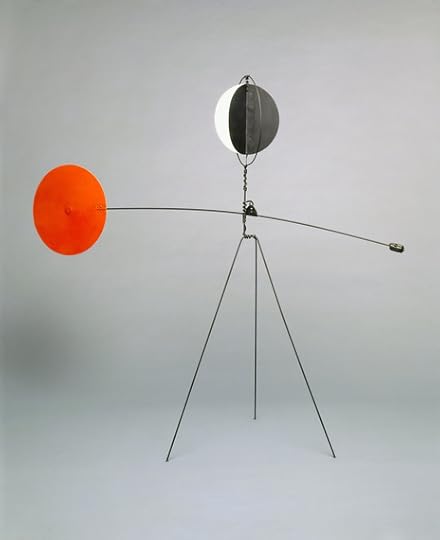
The result is a stunning collection of works that seem to be three-dimensional versions of abstract paintings. Bold backgrounds of yellow or red with figures and objects raised out towards you in exaggerated relief. These works feel exciting and fresh.
And it is this revolutionary spirit that would lead Alexander to create his mobiles and moving sculpture - arrangements of delicately balanced shapes and objects that move in response to the world around them.
This is sculpture liberated. The absence of weight is uplifting. And this emotion is captured in Alexander's subject matter too.
The magic and wonder of the night sky is wonderfully reflected in Black Constellations, painted wooden planets and stars skilfully connected via thin pieces of wire. And, my favourite piece in the show, Snow Flurry I 1948 - an evocative collection of white spheres delicately hanging from the ceiling. And as the gentle breeze created by the visitors drifts through this mobile, the flurries float like light snowflakes.
It is this elegant, graceful movement that captures the visitor. And the shadows created by these pieces on the pale white walls of the galleries add to their impact. Yet for all the romance there is also impressive technical achievement, reflecting Alexander's training as an engineer.
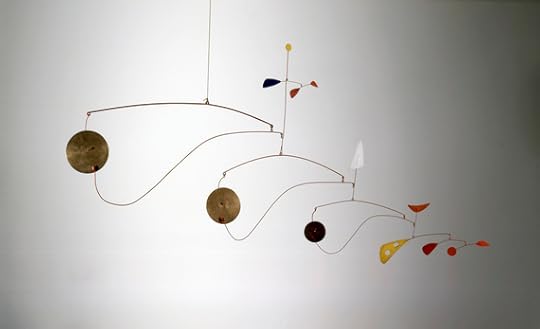
Alexander explored creating motorised mobiles - mobiles that used a motor to turn through pre-set motions. Unfortunately these works are now too delicate to be in constant motion but looking at their construction is fascinating, and the Tate has put on video loops showing the works in motion.
And as well as the smaller, finer pieces, there are also large, dynamic works incorporating numerous weights of significant size that somehow remain balanced on the thinnest of wires. The finest example of this is Black Widow, c.1948, a stunning large scale mobile over three metres high that is on show outside of Brazil for the time ever.
This is the last piece in this fine exhibition and it is a fitting close as it a dramatic piece that impresses as much with its technical achievement as it does with its purpose - Black Widow exists as a powerful visual metaphor of the post-war world, an era of new beginnings and a rejection of the previous social order.
It is hard for any image to do a work of art justice, but you feel that acutely with Alexander's mobiles. Their scale and their emotional impact is hard, if not impossible, to convey in a still image. This collection of some of his works is a rare opportunity to witness his brilliance and feel the delight for yourself. Take this opportunity!
Tate Modern, London to April 3, 2016
Image Credits:
1.Alexander Calder (1898 - 1976), Red and Yellow Vane 1934 Calder Foundation, New York, NY, USA Photo credit: Calder Foundation, New York / Art Resource, NY © ARS, NY and DACS, London 2014
2.Alexander Calder (1898 - 1976), Triple Gong c.1948 Calder Foundation, New York, NY, USA Photo credit: Calder Foundation, New York / Art Resource, NY © ARS, NY and DACS, London 2015
Mobiles are so common to us now that we rarely consider how they were created. But Alexander did create them. And the Tate Modern has brought together 100 of his works, some of which have never been seen in the UK before, in an impressive show that allows visitors to see the development and achievements of this pioneering artist.
Alexander was always fascinated by freeing sculpture from the burden of heavy materials such as marble and bronze. You can see this in his early works as he experimented with engaging figurative wire portraits, whether this a sculpture of tennis player Helen Wills Moody reaching for a volley at the net, or work that captures the sensual curves of performer Josephine Baker.
But it was a meeting with the abstract artist Mondrian that propelled Alexander in a new direction.
On visiting Piet Mondrian's studio, Alexander was captivated by the pure abstraction and wondered whether such an approach could be reflected in sculpture. Piet Mondrian was sceptical but where he saw only limitations, Alexander saw possibilities.

The result is a stunning collection of works that seem to be three-dimensional versions of abstract paintings. Bold backgrounds of yellow or red with figures and objects raised out towards you in exaggerated relief. These works feel exciting and fresh.
And it is this revolutionary spirit that would lead Alexander to create his mobiles and moving sculpture - arrangements of delicately balanced shapes and objects that move in response to the world around them.
This is sculpture liberated. The absence of weight is uplifting. And this emotion is captured in Alexander's subject matter too.
The magic and wonder of the night sky is wonderfully reflected in Black Constellations, painted wooden planets and stars skilfully connected via thin pieces of wire. And, my favourite piece in the show, Snow Flurry I 1948 - an evocative collection of white spheres delicately hanging from the ceiling. And as the gentle breeze created by the visitors drifts through this mobile, the flurries float like light snowflakes.
It is this elegant, graceful movement that captures the visitor. And the shadows created by these pieces on the pale white walls of the galleries add to their impact. Yet for all the romance there is also impressive technical achievement, reflecting Alexander's training as an engineer.

Alexander explored creating motorised mobiles - mobiles that used a motor to turn through pre-set motions. Unfortunately these works are now too delicate to be in constant motion but looking at their construction is fascinating, and the Tate has put on video loops showing the works in motion.
And as well as the smaller, finer pieces, there are also large, dynamic works incorporating numerous weights of significant size that somehow remain balanced on the thinnest of wires. The finest example of this is Black Widow, c.1948, a stunning large scale mobile over three metres high that is on show outside of Brazil for the time ever.
This is the last piece in this fine exhibition and it is a fitting close as it a dramatic piece that impresses as much with its technical achievement as it does with its purpose - Black Widow exists as a powerful visual metaphor of the post-war world, an era of new beginnings and a rejection of the previous social order.
It is hard for any image to do a work of art justice, but you feel that acutely with Alexander's mobiles. Their scale and their emotional impact is hard, if not impossible, to convey in a still image. This collection of some of his works is a rare opportunity to witness his brilliance and feel the delight for yourself. Take this opportunity!
Tate Modern, London to April 3, 2016
Image Credits:
1.Alexander Calder (1898 - 1976), Red and Yellow Vane 1934 Calder Foundation, New York, NY, USA Photo credit: Calder Foundation, New York / Art Resource, NY © ARS, NY and DACS, London 2014
2.Alexander Calder (1898 - 1976), Triple Gong c.1948 Calder Foundation, New York, NY, USA Photo credit: Calder Foundation, New York / Art Resource, NY © ARS, NY and DACS, London 2015
Published on December 02, 2015 03:34



